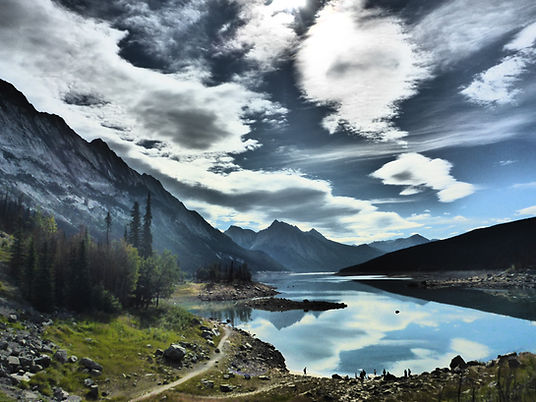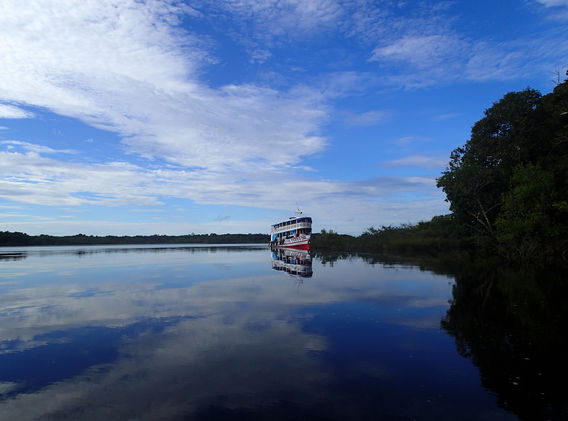

Tonya DelSontro, Ph.D.
Assistant Professor, University of Waterloo
Dept. of Earth and Environmental Sciences
PREVIOUS PROJECTS
Methane emission hot spots and carbon burial in Brazilian hydropower reservoirs
Co-advising Annika Linkhorst, a doctoral student of Dr. Sebastian Sobek at Uppsala University
ERC project - HYDROCARB
The current push for hydropower is concentrated in developing countries and often in tropical regions, such as Amazonian Brazil, but carbon budgets for tropical reservoirs are not well constrained due to mostly a lack of adequate data. An often overlooked aspect of reservoir carbon budgets has been methane emissions, particularly ebullitive (bubbling) emissions. Some of my dissertation work revealed that methane hot spots could disproportionately contribute to total emissions, even in quite large reservoirs (e.g., DelSontro et al. 2011 in ES&T). Dr. Sebastian Sobek has combined this idea with the fact that reservoirs could potentially act as carbon sinks by storing carbon via the typically high sedimentation rates in reservoirs and succeeded in acquiring the prestigious early career grant from the European Research Council. I am currently advising one of his PhD students, Annika Linkhorst, on the acquisition and analysis of hydroacoustic measurements of ebullition. Below are some pictures from our first field campaign on Chapeau d'Uvas reservoir near Juiz de Fora. The Brazilian collaborators include Dr. Nathan Barros and Dr. Raquel Mendoca at Juiz de Fora University (seen below with their son, Theo, who was born during that first field campaign).
Methane dynamics along the Amazon River
In 2014, I was invited by Dr. David Bastviken (Linköping University, Sweden) and Dr. Alex Enrich-Prast (Federal University of Rio de Janeiro, Brazil) to participate on an Amazon River cruise field campaign. My task during the first two weeks of a two month campaign was to set-up an echosounder for hydroacoustic monitoring of ebullition in the river. A master's student, Rafaela Flach, continued data collection. Check back later for updates on this project.
Methane dynamics along the Aare River, downstream of the Wohlensee reservoir, Switzerland
In 2012 and 2013, I supervised the projects of a master's and a doctoral student at ETH Zürich. Both students were investigating the spatiotemporal dynamics of methane (CH4) along the Aare River, which flows from the Alps to the lowlands and through the capital city of Bern and the run-of-river hydroelectric reservoir, Wohlensee. We recently published the results of the master student (Karina Perez) that showed a strong temporal variability in CH4 dynamics as well as a large spatial gradient that was controlled by the confluence with a smaller tributary (DelSontro et al. 2016). The most significant CH4 loss was observed at this confluence, presumably because of enhanced turbulence and resulting gas exchange where the two rivers meet. Interestingly, no significant CH4 loss occurred across the hydroelectric dam; therefore, CH4 accumulated in the reservoir, which was mostly due to ebullition, was transported downstream to the Aare River.

International workshop on reservoir GHG emissions at the Three Gorges Dam, China
In June 2012, I participated in an international workshop at the Three Gorges Dam in China. The workshop had two aims: (1) to compare methods for CH4 and CO2 measurements from reservoir surfaces using floating chambers and hydroacoustics, and (2) to instruct Chinese students on the use of such instrumentation. The project was organized by Dr. Brad Sherman, formerly at CSIRO, Australia, and included Dr. Atle Harby from SINTEF (Norway), Dr. Maud Demarty from Environnement Illimité (Canada), Dr. Alain Tremblay from Hydro-Québec (Canada), Prof. Bingfang Wu from the Key Laboratory of Digital Earth Sciences at the Chinese Academy of Sciences, and Dr. Yan Zhao, now at the University of Queensland (Australia). The results from the four chamber teams (Norway, Canada, Australia, and China), each with a slightly different chamber configuration, agreed within 20%. Unfortunately, the locations where chamber comparisons were conducted did not have ebullitive emissions for a suitable comparison with the hydroacoustic method, which was my task. Echosounder surveys along two tributaries revealed that some ebullition occurred at the inflow to the main river rather than further upstream in the tributary, but depths were in excess of ~60 m and bubbles did not readily reach the surface. Workshop results were published in 2015 (Zhao et al. 2015).
 |  |
|---|---|
 |  |
 |  |
 |  |
 |  |
 |  |
 |  |
Spatial heterogeneity of sediment CH4 dynamics, Rhone River delta of Lake Geneva, Switzerland
Work during my first postdoc took place on Lake Geneva where the Rhone River enters and has created a series of subaquatic canyons that track the movements of the river over the years. A Swiss project called ELEMO took place in summer 2011 in which the two MIR submersibles from the Russian Academy of Sciences were used to conduct numerous projects in the depths of the lake. Dr. Sebastien Sollberger, who was at the time a doctoral student, and I participated in several dives to collect cores from three of the canyons, including the 50 m high canyon where the Rhone River currently enters. I was senior author on the paper in which we found that methane production and emission varied between canyons relative to their age and along canyons relative to other sediment characteristics, such as grain size composition and organic matter content (Sollberger et al. 2014). Across the main canyon the most active production and ebullition was found on the levees of the channel where sedimentation rates are higher. All ELEMO studies were published in a special issue in Aquatic Sciences.
 |  |
|---|---|
 |  |
 |  |
 |  |
 |  |
 |  |
 |  |
 |  |
 |
Sediment trapping by dams creates methane emission hot spots, River Saar, Germany
In 2010, I joined a two week long field campaign along the River Saar in southwestern Germany to investigate how the many dams along that river impact the methane dynamics and emissions. The project was led by Dr. Andreas Maeck and Dr. Andreas Lorke of the University of Koblenz at Landau. We found that the higher sedimentation rates behind dams and in river bends where river velocities were reduced led to areas of higher methane production and ebullition (Maeck et al. 2013). I coordinated the hydroacoustic efforts of the project, including calibration of the echosounder and data analysis.



























